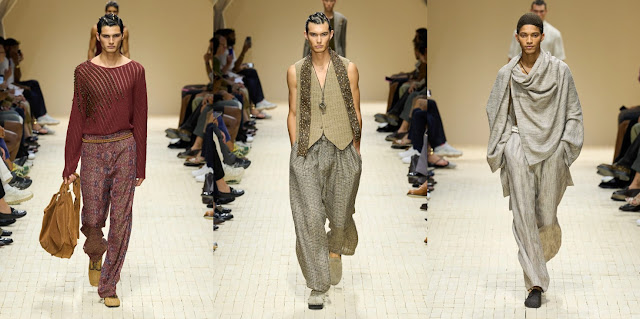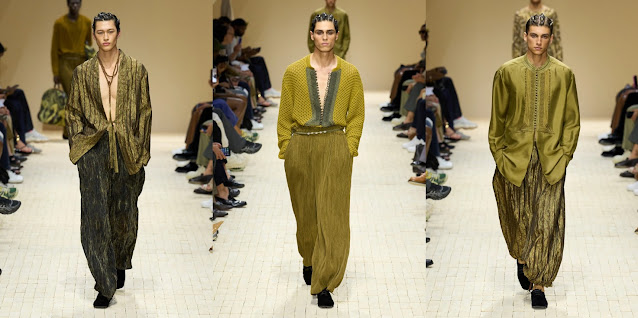Monday, June 23, 2025
BEAUTY: Clothing--Emporio Armani
Giorgio Armani was in hospital recently and was not able to attend this SS '26 show at Milano Moda Uomo--the first time ever he has missed a show. He is nearly 91 after all, but reports are that he is doing just fine.
Regular readers know by now that an Emporio Armani or Armani show means a cut-and-paste moment from all my past posts about Giorgio. So yes, here we are again.
I love Giorgio Armani: I say it every time I blog about his work. Every season for his own eponymous label or for his Emporio Armani line (the more causal and sportier version of Armani), I swoon at what his house creates and sends down the runway. I respond most to designers, designs, and shows that have a strong inspiration and concept, and a near-performance art presentation. But Armani does not need concepts. He has been creating his own sense of easy luxury for nearly half a century now, and it's still fresh and relevant today.
He deconstructed the men's suit in the 80s, turning it into something soft and sensual, something sexy and flowing, without altering the basic concept of what it was. He removed layers of felting inside suits, making them relaxed and able to behave like thin silk. Just take a look at the iconic clothing from the film "American Gigolo" and you will see what I mean. It was soft and casual with a sense of effortless power. This revolution rippled out into the industry and we see its waves even now: designers still grapple with ways to make suiting less stiff, to make clothing more luxe without being precious, and to make pieces with more innate ease without being sloppy. In short, to make clothes more Armani. But no one does Armani like Armani. Clean lined and impeccably tailored, Armani's sensibility is about luxe fabrics and the way a garment hangs and drapes on the body (of both men and women).
But there is something else that I really respond to in each Armani collection and that is a vague sense, a shadow, an echo of historical fashion. The way a jacket or coat is cut or its stance, the inclusion of waistcoats, belted outerwear, loose cut and high waisted trousers...it all reminds me of...what, the 1920s and 30s? The 1880s? The 1940s and 50s? Yes to all of it.
But this SS '26 collection does have a strong theme and was elevated even beyond the expected spectacular-ness in the form of references to North and Central Africa as well as Central Asia. Called "Origins," the garments, all in swoon-worthy desert colors, ranged from the usual Armani-cut supple suits in insanely luxe materials to loose billowy trousers, tunics, long overshirts and jackets in metallic-finish silks, generous smocks, kurtas, rattan hats, bejeweled skull caps, and a jacket made out of feathers (look #35)! I love the accessorizing--all the neckwear is gloriously beautiful and the twisted rows of hair with cuffs was a lovely touch. And the models walked a runway that was lined with sun-baked clay bricks from Morocco.
It's a bold move in this day of cries of "cultural appropriation" to present a collection based on inspiration from a source not native to oneself, but I like how the show notes put it (read them at the bottom): "a genuine interest in other cultures and a passion for different ways of expressing oneself through the everyday act of dressing." Yes, I agree.
https://www.armani.com/
Regular readers know by now that an Emporio Armani or Armani show means a cut-and-paste moment from all my past posts about Giorgio. So yes, here we are again.
I love Giorgio Armani: I say it every time I blog about his work. Every season for his own eponymous label or for his Emporio Armani line (the more causal and sportier version of Armani), I swoon at what his house creates and sends down the runway. I respond most to designers, designs, and shows that have a strong inspiration and concept, and a near-performance art presentation. But Armani does not need concepts. He has been creating his own sense of easy luxury for nearly half a century now, and it's still fresh and relevant today.
He deconstructed the men's suit in the 80s, turning it into something soft and sensual, something sexy and flowing, without altering the basic concept of what it was. He removed layers of felting inside suits, making them relaxed and able to behave like thin silk. Just take a look at the iconic clothing from the film "American Gigolo" and you will see what I mean. It was soft and casual with a sense of effortless power. This revolution rippled out into the industry and we see its waves even now: designers still grapple with ways to make suiting less stiff, to make clothing more luxe without being precious, and to make pieces with more innate ease without being sloppy. In short, to make clothes more Armani. But no one does Armani like Armani. Clean lined and impeccably tailored, Armani's sensibility is about luxe fabrics and the way a garment hangs and drapes on the body (of both men and women).
But there is something else that I really respond to in each Armani collection and that is a vague sense, a shadow, an echo of historical fashion. The way a jacket or coat is cut or its stance, the inclusion of waistcoats, belted outerwear, loose cut and high waisted trousers...it all reminds me of...what, the 1920s and 30s? The 1880s? The 1940s and 50s? Yes to all of it.
But this SS '26 collection does have a strong theme and was elevated even beyond the expected spectacular-ness in the form of references to North and Central Africa as well as Central Asia. Called "Origins," the garments, all in swoon-worthy desert colors, ranged from the usual Armani-cut supple suits in insanely luxe materials to loose billowy trousers, tunics, long overshirts and jackets in metallic-finish silks, generous smocks, kurtas, rattan hats, bejeweled skull caps, and a jacket made out of feathers (look #35)! I love the accessorizing--all the neckwear is gloriously beautiful and the twisted rows of hair with cuffs was a lovely touch. And the models walked a runway that was lined with sun-baked clay bricks from Morocco.
It's a bold move in this day of cries of "cultural appropriation" to present a collection based on inspiration from a source not native to oneself, but I like how the show notes put it (read them at the bottom): "a genuine interest in other cultures and a passion for different ways of expressing oneself through the everyday act of dressing." Yes, I agree.
https://www.armani.com/
Subscribe to:
Post Comments (Atom)


















No comments:
Post a Comment